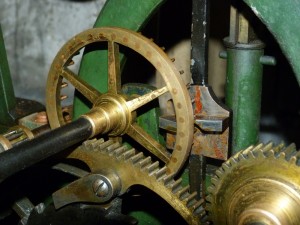Logically one of the first things we want to get sorted is the going train – no point being able to chime before it can tell the time (although we did already take a slight detour with the arbour supports). To do this we need to replace the following missing parts:
- the pendulum stand
- the pendulum
- the escapement
- the escapement arbour and lantern pinion
This involves many unknowns. We don’t know the length (and so the period) of the pendulum. We don’t know what kind of escapement it should have. From looking at many similar Smith clocks on the internet (we are yet to find one identical) we are pretty sure it uses a pin wheel escapement. We don’t know how many pins, although most we have seen have 35 pins. We don’t know how many trundles the lantern pinion (opposite end of the arbour to the escape wheel) should have, no clear pictures found on the internet. However, we do know that the next wheel in the train has 120 teeth, and needs to make 4 full rotations per hour, so we can work backwards to make some sensible suggestions for our unknowns.
120 teeth rotating 4 times per hour makes 480 teeth per hour. With 3600 seconds per hour we need to move one of these teeth every 7.5 seconds. Some measuring of the teeth on the 120 wheel suggest a lantern pinion with 10 trundles. If we assume 35 pins on the escape wheel we have enough information to work out a pendulum length: 7.5 seconds x 10 trundles = 75 seconds per rotation of the escapement arbour. 75 divided by 35 ~= 2.14 seconds for a full swing (back and forth) for the pendulum, which translates into a pendulum length of 1.14m.
Picture is of the escapement of South Mymms Church clock, J Smith & Sons (Derby) ~1892, taken by Harald Mueller.
